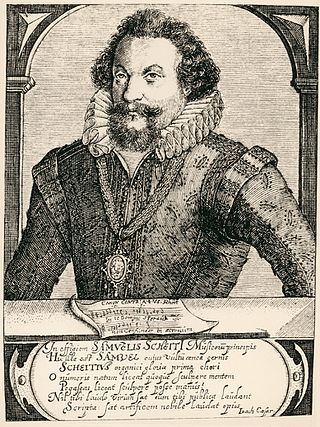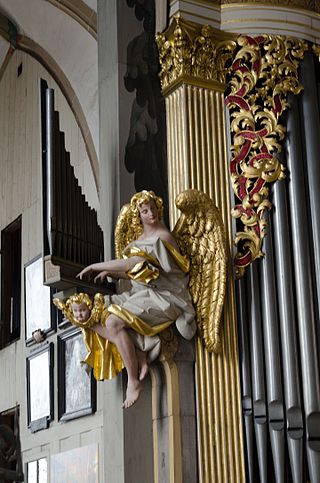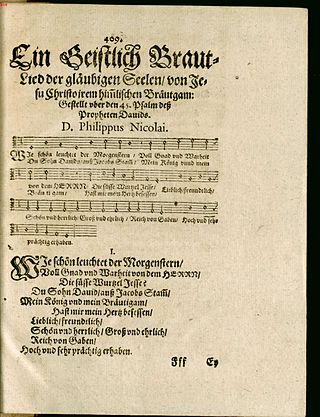Johann Pachelbel was a German composer, organist, and teacher who brought the south German organ schools to their peak. He composed a large body of sacred and secular music, and his contributions to the development of the chorale prelude and fugue have earned him a place among the most important composers of the middle Baroque era.

Charles-Marie-Jean-Albert Widor was a French organist, composer and teacher of the late Romantic era. As a composer he is known for his ten organ symphonies, especially the toccata of his fifth organ symphony, which is frequently played as recessional music at weddings and other celebrations.

Marcel Jean-Jules Dupré was a French organist, composer, and pedagogue.

César-Auguste-Jean-Guillaume-Hubert Franck was a French Romantic composer, pianist, organist, and music teacher born in present-day Belgium.

Johann Baptist Joseph Maximilian Reger was a German composer, pianist, organist, conductor, and academic teacher. He worked as a concert pianist, as a musical director at the Leipzig University Church, as a professor at the Royal Conservatory in Leipzig, and as a music director at the court of Duke Georg II of Saxe-Meiningen.

Toccata is a virtuoso piece of music typically for a keyboard or plucked string instrument featuring fast-moving, lightly fingered or otherwise virtuosic passages or sections, with or without imitative or fugal interludes, generally emphasizing the dexterity of the performer's fingers. Less frequently, the name is applied to works for multiple instruments.

Samuel Scheidt was a German composer, organist and teacher of the early Baroque era.

In music, a chorale prelude or chorale setting is a short liturgical composition for organ using a chorale tune as its basis. It was a predominant style of the German Baroque era and reached its culmination in the works of J.S. Bach, who wrote 46 examples of the form in his Orgelbüchlein, along with multiple other works of the type in other collections.
Johann Ludwig Krebs was a German Baroque musician and composer for the pipe organ, harpsichord, other instruments and orchestras. His output also included chamber music, choral works and concertos.
Wolfgang Friedrich Rübsam is a German-American organist, pianist, composer and pedagogue.

Johann Sebastian Bach was a German composer and musician of the late Baroque period. He is known for his orchestral music such as the Brandenburg Concertos; instrumental compositions such as the Cello Suites; keyboard works such as the Goldberg Variations and The Well-Tempered Clavier; organ works such as the Schubler Chorales and the Toccata and Fugue in D minor; and vocal music such as the St Matthew Passion and the Mass in B minor. Since the 19th-century Bach revival he has been generally regarded as one of the greatest composers in the history of Western music.

Prelude and Fugue in A minor, BWV 543 is a piece of organ music written by Johann Sebastian Bach sometime around his years as court organist to the Duke of Saxe-Weimar (1708–1713).
In music a voluntary is a piece of music, usually for an organ, that is played as part of a church service. In English-speaking countries, the music played before and after the service is often called a 'voluntary', whether or not it is so titled.

"Wie schön leuchtet der Morgenstern" is a Lutheran hymn by Philipp Nicolai written in 1597 and first published in 1599. It inspired musical settings through centuries, notably Bach's chorale cantata Wie schön leuchtet der Morgenstern, BWV 1, but also vocal and instrumental works by Baroque composers, Peter Cornelius, Felix Mendelssohn, Max Reger, Hugo Distler, Ernst Pepping, Mauricio Kagel and Naji Hakim.

The Clavier-Übung III, sometimes referred to as the German Organ Mass, is a collection of compositions for organ by Johann Sebastian Bach, started in 1735–36 and published in 1739. It is considered Bach's most significant and extensive work for organ, containing some of his most musically complex and technically demanding compositions for that instrument.
Nazario Carlo Bellandi was an Italian music composer, organist, pianist, harpsichordist.

Chorale is the name of several related musical forms originating in the music genre of the Lutheran chorale:

Throughout the 18th century, the appreciation of Johann Sebastian Bach's music was mostly limited to distinguished connoisseurs. The 19th century started with publication of the first biography of the composer and ended with the completion of the publication of all of Bach's known works by the Bach Gesellschaft. A Bach Revival had started from Mendelssohn's performance of the St Matthew Passion in 1829. Soon after that performance, Bach started to become regarded as one of the greatest composers of all times, if not the greatest, a reputation he has retained ever since. A new extensive Bach biography was published in the second half of the 19th century.

Gereon Krahforst is a German composer, concert organist, pianist, harpsichordist and church musician.













